
|
Sale 72
February 2-5. 2013
| Lot |
Photo |
Description |
Realized |
Lot 4000 |
 |
Celtic Coinage, Middle Danube. Uncertain tribe. Silver Tetradrachm (12.32g) struck late 2nd-early 1st Century BC. Variant of the Kroisbach/Reiterstumpf type. Celticized head of Apollo left with a low, jutting brow and hair formed of heavy reversed 'S'-shaped curls. Reverse: Celtic rider, showing only torso and above, with plaited curving locks, on horseback left; twisting groundline below terminating in torque at each end. Unpublished in standard references; cf. Gorny & Mosch 141, lot 22. Minor mark on cheek. Attractively toned. Very rare. Extremely Fine.
These handsome, recently discovered types are derived from the coinage of Philip II of Macedon: the obverse from his staters, the reverse from his tetradrachms.
Estimated Value $5,000 - 6,000.
View details and enlarged photos
| Realized
$7,188 |
Lot 4001 |
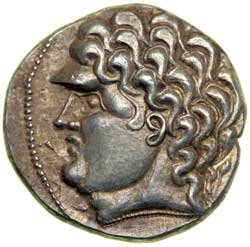 |
Celtic Coinage, Middle Danube. Uncertain tribe. Silver Tetradrachm (12.7g) struck late 2nd-early 1st Century BC. Variant of the Kroisbach/Reiterstumpf type. Celticized head of Apollo left with a low, jutting brow and hair formed of heavy reversed 'S'-shaped curls. Reverse: Celtic rider, showing only torso and above, with plaited curving locks, on horseback left; horse with a clef-shaped ear; twisting groundline below terminating in torque at each end. Unpublished in standard references; cf. Gorny & Mosch 141, lot 22. Attractively toned. Very rare. Extremely Fine.
Estimated Value $5,000 - 6,000.
View details and enlarged photos
| Realized
$7,188 |
Lot 4002 |
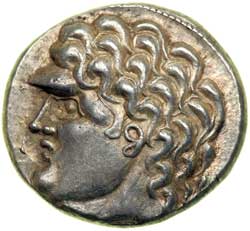 |
Celtic Coinage, Middle Danube. Uncertain tribe. Silver Tetradrachm (12.78g) struck late 2nd-early 1st Century BC. Variant of the Kroisbach/Reiterstumpf type. Celticized head of Apollo left with a low, jutting brow and hair formed of heavy reversed 'S'-shaped curls. Reverse: Celtic rider, showing only torso and above, with plaited curving locks, on horseback left; twisting groundline below terminating in torque at each end. Unpublished in standard references; cf. Gorny & Mosch 141, lot 22. Perfectly centered and boldly struck. Very rare. Extremely Fine.
Estimated Value $5,000 - 6,000.
View details and enlarged photos
| Unsold |
Lot 4003 |
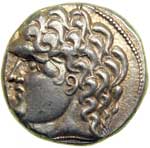 |
Celtic Coinage, Middle Danube. Uncertain tribe. Silver Tetradrachm (12.70g) struck late 2nd-early 1st Century BC. Variant of the Kroisbach/Reiterstumpf type. Celticized head of Apollo left with a low, jutting brow and hair formed of heavy reversed 'S'-shaped curls. Reverse: Celtic rider, showing only torso and above, with plaited curving locks, on horseback left; twisting groundline below terminating in torque at each end. Unpublished in standard references; cf. Gorny & Mosch 141, lot 22. Russet highlights. Very rare. Nearly Extremely Fine.
Estimated Value $4,000 - 5,000.
View details and enlarged photos
| Realized
$3,680 |
Lot 4004 |
 |
Celtic Coinage, Serbia. Silver Tetradrachm (12.72g) struck 2nd Century BC. Helmschweifreiter type. Laureate, Celticized head of Zeus right with four crescent locks and two wavy "ladle" locks; "E with long curling tail" eye; annulet before 2-line nose; large "chevrons" form laurel wreath. Reverse: Celtic warrior riding horse left, his head formed by three pellets as is his torso; mid-section pellet; his hair plaited in a long braid that curls behind and ends in a pellet; pellet in ring above; profile eye (?) above horse's tail. Göbl 165, 2; BMC S110; Dembski 1104. Well struck of excellent metal. Delicate light antique toning. A very handsome example. Rare. Superb Extremely Fine.
Estimated Value $3,000 - 4,000.
Ex LHS 100, Zurich, 23 April 2007, Lot 5.
View details and enlarged photos
| Realized
$3,335 |
Lot 4005 |
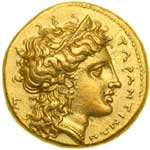 |
Calabria, Tarentum/Taras. Gold Half Stater (4.26g) struck ca. 334-332 BC. TAPANTINΩN. Head right of Hera, wearing stephane, triple-pendant earring and beaded necklace, hair falling in waves down her neck; to left, E. Reverse: TAPAΣ. Naked Taras riding dolphin left, holding a small dolphin left on his outstretched right hand, trident in left; below left, T (horizontal); below right, K. SNG ANS 955; HN Italy 902; Vlasto 5; Jameson 149 (same dies). Natural honey color toning. A magnificent example of the finest style. Superb Extremely Fine.
"E" is probably a signed master die.
The Spartan colony of Taras produced a coinage of remarkable variety over a period of three hundred years, commencing in the late sixth century BC. Gold denominations were issued on several occasions in connection with extraordinary expenses associated with military operations. This gold half stater or drachm, possibly the equivalent of six silver nomoi, appears to date to the period of the intervention of Alexander the 'Molossian' into the affairs of southern Italy (ca. 334-330 BC). The Epirote king was endeavoring to aid the Tarentines in their struggle against the Lucanians and Bruttians of the interior, but the war was terminated by Alexander's death in battle near Pandosia in Bruttium. Although standard on most Tarentine silver issues, the depiction of the dolphin-rider on gold is rare. It refers to Taras, legendary founder of the forerunner of the Greek colony, who was saved from drowning following a shipwreck, when his father Poseidon sent a dolphin to carry the youth safely to the shore.
Estimated Value $15,000 - 20,000.
The Hunter Collection; Ex Numismatica Ars Classica 8, 3 April 1995, lot 27.
View details and enlarged photos
| Realized
$23,000 |
Lot 4006 |
 |
Lucania, Metapontum / Metapontion. Silver Stater (8.2g) struck ca. 540-510 BC. MET. Barley-ear with bracts at base; dotted border. Reverse: Incuse barley-ear. Noe Class I, 12; HN Italy 1459. An exceptional example, lightly toned. Extremely Fine.
This is an outstanding example of the curious incuse or 'mirror' technique that is typical of the archaic phase of coinage in this region of southern Italy. This required the two dies to be precisely adjusted to work in the same axis, a practice that is found nowhere else in the Greek world and was abandoned early in the fifth century BC. Metapontion's constant coin type is an ear of barley, a tribute to the source of the city's wealth.
Estimated Value $3,000 - 4,000.
The Hunter Collection.
View details and enlarged photos
| Realized
$2,990 |
Lot 4007 |
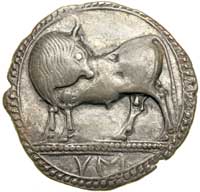 |
Lucania, Sybaris. Silver Stater (8.1g) struck ca. 550-510 BC. VM in exergue; bull standing left, head reverted. Reverse: Incuse bull standing right, head reverted. HN Italy 1729; SNG ANS 828-844; Dewing Coll. 406. Very bold and nicely toned. Nearly Extremely Fine.
An Achaean colony dating from about 720 BC, Sybaris rapidly grew to be the wealthiest city in the area. The luxury enjoyed by its population was proverbial, hence the modern words sybarite and sybaritic. The bull may symbolize the local river god Krathis. The archaic coinage of Sybaris was brought to an abrupt end in 510 BC when the city was destroyed by the rival state of Kroton. The waters of the Krathis were diverted to flow over the site of the sacked city, thus obliterating all trace of its former splendor.
Estimated Value $3,000 - 4,000.
The Hunter Collection.
View details and enlarged photos
| Realized
$3,220 |
Lot 4008 |
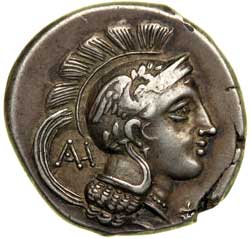 |
Lucania, Velia. Silver Didrachm (7.28g) struck ca. 300-280 BC. Head of Athena right wearing a crested Attic helmet decorated laterally with a wing extending from the crown, pendant earring and a beaded necklace; behind, AH; before, Φ. Reverse: Lion walking right; above, ear of wheat flanked by Φ and I; below its belly, Π. HN III 1309, Williams 470 ff. Minor flan crack at lower obverse edge. Attractively toned medium antique gray. Choice Very Fine.
Estimated Value $2,000 - 2,500.
Ex Bank Leu 2, 25 April 1972, Lot 49; Kricheldorf 5, 20 October 1958, Lot 14.
View details and enlarged photos
| Realized
$1,668 |
Lot 4009 |
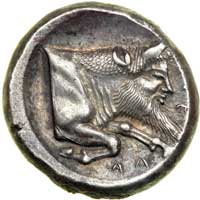 |
Sicily, Gela. Silver Didrachm (8.6g) struck ca. 490-475 BC. [G]E - LA (retrograde). Forepart of man-headed bull running right. Reverse: Naked horseman in peaked helmet galloping right, brandishing spear in right hand, holding reins in left. SNG ANS 5; Jenkins 19. Attractive antique toning. Extremely Fine.
This superbly preserved didrachm of the southern Sicilian city of Gela belongs to the time of the tyrants Gelon and Hieron, subsequently rulers of Syrakuse. The obverse honors the cavalry for which Gela was justly famous, while the man-headed bull on the reverse represents the river god Gelas who is named in the accompanying inscription. The city stood at the mouth of the Gelas and commanded its fertile plain.
Estimated Value $2,500 - 3,000.
The Hunter Collection.
View details and enlarged photos
| Realized
$2,990 |
Lot 4010 |
 |
Sicily, Himera. Silver Tetradrachm (17.29g) struck ca. 409-407 BC. Obverse die signed by the artist Mai…. Himera driving fast quadriga right, holding reins in both hands, her team unruly; above, Nike (Victory) flying left, holding a wreath and a tablet inscribed MAI. Reverse: Himera standing facing, head left, wearing long chiton and peplos, sacrificing with a patera over a horned altar, her left hand raised; to right, satyr three-quarters right bathing in a fountain below a lion-headed spout. Arnold-Biucchi, 22; Gutmann-Schwabacher 20; Rizzo pl. 21, 23; Basel 306; Kraay-Hirmer 71. Slight double striking on reverse. Lustrous. Nearly Mint State.
Probably representing the final issue of Himera prior to the destruction of the city by the Carthaginians in 409/408 BC, this tetradrachm bears the abbreviated name of the artist responsible for the dies, as was the case with many of the late fifth century Sicilian coins. The Carthaginians felt a special enmity towards the Himeraeans, as the city had been the scene of the famous defeat of Hamilcar's invasion of 480 BC launched in response to a request from the deposed Himeraean tyrant Terillus. This pivotal Greek success had been commemorated by the construction of a fine hexastyle Doric temple at Himera, the remains of which were excavated in 1929-30. Notable among the surviving architectural elements of the building were fifty-six beautiful lion-head waterspouts, which may help to explain a curious element of the reverse design: to the right of the standing figure of the nymph Himera, a naked satyr is shown bathing under a fountain in the form of a lion's head.
Following the disaster of 409/408 BC those citizens who had survived the destruction of Himera were permitted by the Carthaginians to move several miles to the west where there were hot springs. Here they established a new settlement, appropriately named Thermae Himeraeae. Ironically, this city was to be the birthplace of Agathokles, later tyrant of Syrakuse and champion of the Greek cause against the Carthaginians.
Estimated Value $7,000 - 10,000.
The Hunter Collection; Hand selected from the hoard in the 1980s by Numismatic Fine Arts.
View details and enlarged photos
| Realized
$7,188 |
Lot 4011 |
 |
Sicily, Camarina / Kamarina. Silver Tetradrachm (16.96g) ca. 425-405 BC. Obverse die signed by Exakestidas. Athena driving galloping quadriga right, holding kentron in her right hand, reins in her left, Nike (Victory) flying left above to crown her with a filleted wreath; signature of Exakestidas on exergual line; two amphorai in exergue. Reverse: Herakles head left clad in lion skin. Westermark & Jenkins 149 (O8/R15); SNG Lockett 725; Rizzo pl. V, 11; SNG ANS 1205; SNG Lloyd 871; Boston MFA 260; SNG Fitzwilliam 944; Pozzi 401; SNG Ashmolean 1699. Natural gray toning. A very pleasing example of this rare and masterly signed issue. Small edge split. Choice Very Fine.
Numismatically, until the last quarter of the fifth Century BC, Kamarina was largely unremarkable, producing various small value issues as well as a few didrachm issues. Then, ca. 425 BC, coinage blossomed with a series of majestic tetradrachms, notably those issues signed by Exakestidas, as well as didrachms, drachms, hemidrachms and litrai. For some two decades, this new coinage and apparent new prosperity flourished but was ended by the aggression of Carthage. As Carthage conquered and destroyed Sicilian cities in the last decade of the fifth century, the citizens of Kamarina were evacuated by their mother-city, Syrakuse. Kamarina virtually ceased to exist until refounded by Timoleon in 399 BC, and from then on, coinage was reduced to minute issues of silver and non-distinctive bronze.
Estimated Value $20,000 - 25,000.
Ex Wolfen Family Foundation; Ex Bank Leu, sale 7, Zürich (9 May 1973), lot 57; Hess-Leu sale 1959, lot 56; Hess-Leu sale 1957, lot 67.
View details and enlarged photos
| Realized
$17,825 |
Lot 4012 |
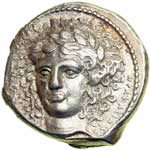 |
Sicily, Catana / Katane. Silver Tetradrachm (17.0g) struck ca. 410-403 BC. Obverse die signed by Herakleidas. HPAKΛEIΔAΣ. Laureate head of Apollo facing, inclined slightly to left, his hair in curls fanning out around his head. Reverse: KATANAIΩN. Fast quadriga left; above, Nike (Victory) right descending to crown charioteer; in exergue, fish left. Dewing 586 = Jameson 546 (same dies); Rizzo 11. Delicately toned. An incredible masterpiece. Extremely Fine.
This masterpiece of late fifth century Greek Sicilian numismatic art bears the full signature of the artist Herakleidas.
The frontal portrait of Apollo, showing his hair in a rich profusion of loose curls, is accompanied on the reverse by a depiction of a victorious charioteer crowned by Nike (Victory). This motif had been typical of Sicilian tetradrachms from the time of Gelon, tyrant of Gela and later of Syrakuse (died 478 BC), and doubtless had its origin in Gelon's success in the chariot races at the Olympian games of 488 BC. Catana / Katane (modern Catania) was a Chalcidian city colonized by Naxos in 729 BC and lay at the southern extremity of the slopes of Mount Aetna. Between 476 and 461 BC, the city actually bore the name of Aetna following its capture by Hieron of Syrakuse.
The remarkable tetradrachm issued at this time, represented by a unique specimen in Brussels, is widely regarded as one of the masterpieces of late Archaic Greek art. The silver coinage of Katane/Catana came to an abrupt end in 404 BC when the city was again captured by the Syrakusans and its population sold into slavery.
Estimated Value $40,000 - 60,000.
The Hunter Collection; Ex Giessener Münzhandlung 50, 24 September 1990, lot 144; Lanz 24, 25 April 1983, lot 83.
View details and enlarged photos
| Realized
$35,650 |
Lot 4013 |
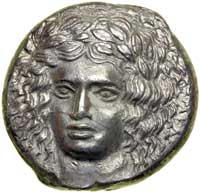 |
Sicily, Catana / Katane. Silver Tetradrachm (16.4g) struck ca. 405-402 BC. Obverse die signed by Herakleidas. HPAKΛ[EIΔAΣ]. Laureate head of Apollo facing, inclined slightly to left, his hair in loose waves around his face. Reverse: [KA]TANAIΩ[N]. Fast quadriga left, the third horse looking back, the fourth looking to its right; above, Nike (Victory) flying right to crown charioteer; in exergue (off-flan), fish left. Kraay-Hirmer 43 (same dies); Rizzo pl. xiv, 10 (same dies) Gulbenkian 190 (same dies). A little rough at 6 o'clock and 11 o'clock on the reverse. The obverse is exceptionally clean. Extremely Fine/Very Fine.
This is considered to be the most attractive of the two dies Herakleidas cut for Katane. The facing head of Apollo is engraved with extraordinary skill in extremely high relief. A true masterpiece of Greek art.
In the last decade of the fifth Century BC, the Second Sicilian War began to embroil the island. Sicily would be torn asunder for many years as Carthage and Syrakuse each sought domination. As if in defiance of the sword, spear and fire and in celebration of the vitality of the island and its cities, this time marks the beginning of one of the most creative and artistic periods of Greek coinage. In Katane, this period is heralded by the remarkable tetradrachms of Herakleidas. Bringing Apollo to the obverse and tilting his head only slighty to the left, Herakleidas depicts him with wide piercing eyes and a strong gaze. The viewer is, indeed, brought face to face with a god. Herakleidas then skillfully tempers Apollo's arresting gaze, for one should not stare directly at a god (partially done by Apollo's slight turn to the left), with flowing locks of hair. On the reverse, he offers the viewer the fluid motion of the horses and the drama of each with the realistic bending of the charioteer's body to control these elemental forces.
Estimated Value $30,000 - 40,000.
The Hunter Collection, Ex Christie's May 2, 1989, lot 627 (front cover) realized $49,500.
View details and enlarged photos
| Realized
$29,900 |
Lot 4014 |
 |
Sicily, Syrakuse. Deinomenid Tyranny, 585-466 BC. Silver Tetradrachm (17.4g) struck ca. 474-470 BC. Slow quadriga right, the bearded charioteer holding kentron in right hand, reins in left; above, Nike (Victory) flying right to crown horses. Reverse: ΣV - RA - KOΣ - ION (R inverted, N retrograde). Pearl-diademed head right of Arethusa, the ends of her hair tucked under her diadem, wearing hoop earring with pendant and beaded necklace; around, four dolphins clockwise. Boehringer 320 (V156/R214); Randazzo 487-488 (same dies). Well struck and well centered. Of excellent metal and delicately toned. Extremely Fine.
Estimated Value $3,000 - 4,000.
The Hunter Collection.
View details and enlarged photos
| Realized
$4,600 |
Lot 4015 |
 |
Sicily, Syrakuse. Second Democracy, 466-405 BC. Silver Tetradrachm (17.18g) struck ca. 415-405 BC. Obverse and reverse dies signed by Eumenos. Charioteer driving quadriga left, holding kentron in right hand, reins in left; horses legs all high in tandem (a typical style point of Eumenos); Nike (Victory) flying right above to crown charioteer; in exergue, signature of Eumenos. Reverse: Head of Arethusa left; behind, signature of Eumenos, surrounded by four dolphins. Tudeer 23 (V9/R15); SNG ANS 258; Jameson 792. Oblongish flan. Sharp obverse, well-centered with all four dolphins. Lightly toned. Both signatures complete and bold. Choice Very Fine.
Estimated Value $10,000 - 15,000.
Wolfen Family Foundation, purchased from Bank Leu early 1970s.
View details and enlarged photos
| Realized
$6,900 |
Lot 4016 |
 |
Sicily, Syrakuse. Second Democracy, 466-405 BC. Silver Tetradrachm (17.1g) struck ca. 440-430 BC. Fast quadriga left, the charioteer holding reins and kentron; above, Nike (Victory) flying right to crown charioteer; in exergue, ketos (off flan). Reverse: ΣVPAKOΣI - ON. Head right of Arethusa, hair drawn into a korymbos (top-knot off flan), wearing wire choker; around four dolphins. Boehringer 604 (V296/R410); SNG ANS 199 (same obverse die); Jameson 775 (same dies); Nanteuil 343 (same dies); Weber 1588 (same dies). Fine delicate style with soft pastel tones. Rare and very desirable. About Very Fine/Nearly Extremely Fine.
Estimated Value $2,500 - 3,000.
The Hunter Collection.
View details and enlarged photos
| Realized
$2,530 |
Lot 4017 |
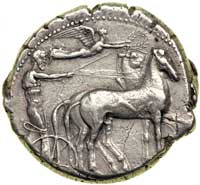 |
Sicily, Syrakuse. Second Democracy, 466-405 BC. Silver Tetradrachm (17.1g) struck ca. 430-420 BC. Slow quadriga right, the charioteer holding reins and kentron; above, Nike (Victory) flying right to crown horses. Reverse: ΣYP - A- [KO] - Σ - [ION]. Head right of Arethusa, her hair bound with ribbon, wearing whorl earring and wire necklace; around, four dolphins. Boehringer 671 (V338/R458); SNG ANS 221. Light antique gray toning, deepening within the recesses. An unusually choice example for the type. Choice Very Fine.
Estimated Value $2,000 - 2,500.
The Hunter Collection.
View details and enlarged photos
| Realized
$7,188 |
Lot 4018 |
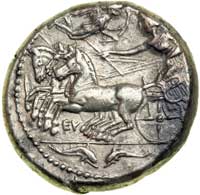 |
Sicily, Syrakuse. End of Second Democracy, 415-405 BC. Silver Tetradrachm (17.2g). Obverse and reverse dies signed by Eukleidas and Eumenos. Fast quadriga left, the charioteer holding kentron in outstretched right hand, reins in left; above, Nike (Victory) flying right to crown charioteer; below horses, EV; in exergue, two dolphins confronted. Reverse: [ΣVPAKO]ΣION (N retrograde). Head of Arethusa left, wearing earring and wire choker; below neck truncation, EV; around, four dolphins. SNG ANS 260; Tudeer 27 (10/18). Lightly toned. Very rare. Nearly Extremely Fine.
In the last quarter of the fifth century BC there was a significant change in the Syrakusan tetradrachm coinage. Individual artists began signing their work on the dies and, as the series progressed, the representation of the victorious charioteer took on a more realistic three-quarter-face appearance that gave the scene something closer to a three-dimensional character.
This handsome specimen comes at the beginning of the transitional phase. While it bears two signatures, on obverse and reverse, the quadriga is still shown in profile as on the earlier fifth century issues. Both signatures appear as "EV" though two artists are probably involved here, likely Eukleidas and Eumenos.
Estimated Value $7,000 - 8,000.
The Hunter Collection.
View details and enlarged photos
| Realized
$7,188 |
Lot 4019 |
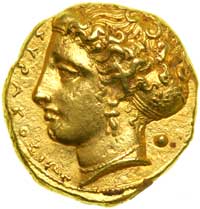 |
Sicily, Syrakuse. Gold 100 Litrai or Double Dekadrachm (5.8g) struck ca. 405-400 BC. ΣYPAKOΣIΩN. Head of Arethusa left, her hair bound in sphendone adorned with stars, wearing triple-pendant earring and beaded necklace; to right, pellet. Reverse: Youthful Herakles kneeling right, strangling Nemean lion. SNG ANS 326; Berend 13; de Ciccio 51. Extremely Fine.
This charming gold 100-litrai piece of the early fourth century BC dates to the time of the Syrakusan tyrant Dionysios I. The female head, presumably representing the fountain nymph Arethusa, is similar to that appearing on the medallic silver decadrachms engraved by the artist Kimon, and some specimens do bear the abbreviated signatures of Kimon and Euainetos. The reverse type of Herakles grappling with the Nemean lion is probably symbolic of Dorian Syrakuse acting as the champion of the Hellenic cause against the barbarian aggression of the Carthaginians.
Estimated Value $10,000 - 13,000.
The Hunter Collection.
View details and enlarged photos
| Realized
$24,150 |
Lot 4020 |
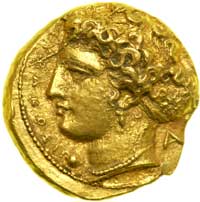 |
Sicily, Syrakuse. Dionysios I, 405-367 BC. Gold 100 Litrai or Double Dekadrachm (5.78g) struck ca. 400-370 BC. Obverse signed by the artist "A." Head of Arethusa left, her hair in ampyx and sphendone adorned with stars, wearing triple-pendant earring and necklace; before, pellet; behind, A. Reverse: Herakles, kneeling right, strangling the Nemean lion. Bérend 23; Rizzo pl. 50, 12; De Ciccio 12 A. As is the norm for this rare issue, struck from somewhat rusty dies. Extremely Fine.
Artist "A" worked concurrently with Euainetos at Syrakuse. At some time fairly soon after the dies of this coin were produced, "A" was joined by artist "K," and coins were struck with "AK" behind the head. These 100 Litrai types were issued in prodigious amounts to pay the mercenaries who swelled the armies of Dionysios. As the troops did not squirrel away their gold, but despoiled themselves of it, these coins were by and large quickly melted down, leaving few extant today.
Estimated Value $8,000 - 9,000.
Wolfen Family Foundation, purchased from Bank Leu early 1970s.
View details and enlarged photos
| Realized
$6,613 |
Lot 4021 |
 |
Sicily, Syrakuse. Dionysios I, 406-367 BC. Silver Dekadrachm (43.15g) struck ca. 405-400 BC. A magnificent product of the master die engraver. Signed twice by Kimon. Fast quadriga left, the female charioteer wearing long chiton and holding kentron in her right hand, reins in her left; above, Nike (Victory) flying right to crown charioteer; in exergue, shield, cuirass flanked by greaves, and crested Attic helmet arrayed on a horizontal step, upon which is inscribed AΘΛA. Reverse: ΣYPAKOΣIΩ. Head of Arethusa left, hair bound by ampyx inscribed K and netted sphendone, wearing single-pendant earring and beaded necklace; around, four dolphins; that below neck truncation, inscribed KIMON. Jongkees 3 (A/γ; same dies); SNG Lockett 988 (same dies); McClean 2734 (same dies). Cf. The Millennia Collection, Lot 12 (same dies). Fine die crack vertically through eye, as is usual with this die. Lightly toned. Extremely Fine.
Long considered the masterpiece of Greek coinage.
The classic elegance of Kimon's interpretation of the head of the fountain nymph Arethusa is shown to full advantage on this superbly preserved medallic dekadrachm of the late fifth century BC. The master engraver's signature appears twice on this reverse die, once as an initial on the ampyx above the nymph's forehead and again, in full, on the dolphin below the truncation. Kimon's dekadrachms are often dated a little earlier than those of Euainetos. In reality, they are probably contemporary with the latter's initial issues, but their production did not extend over as many years.
The typical victorious charioteer theme of the obverse appears to take on a new meaning in this series with the addition of the inscription AΘΛA (prizes) in minute lettering on the step supporting the array of arms. The victory in this case has a military rather than an agonistic connotation and presumably refers to the spoils of war during the protracted struggle with the Carthaginians. Another possible interpretation of the inferred military success is the famous Syrakusan victory over the Athenians in 413 BC.
Estimated Value $100,000 - 125,000.
The Hunter Collection; Ex Numismatic Fine Arts XXX, December 8, 1992, lot 21.
View details and enlarged photos
| Realized
$126,500 |
Lot 4022 |
 |
Sicily, Syrakuse. Dionysios I, 405-367 BC. Silver Dekadrachm (43.49g) struck ca. 400-390 BC. Unsigned dies by Euainetos. Fast quadriga left, the charioteer holding long kentron in his right hand and reins in his left; above, Nike (Victory) flying right to crown charioteer; in exergue, shield, cuirass flanked by greaves, and crested Attic helmet arrayed on a horizontal spear. Reverse: Σ - YPA - K - O - ΣIΩN. Head left of Arethusa, wreathed in grain leaves, wearing triple-pendant earring and beaded necklace; to right, scallop shell; around, four dolphins. SNG ANS 372; Dewing 904-906 (all from the same dies); Gallatin O.XI-R.E.I; cf. Rizzo pl. 54, 1 (reverse) and 4 (same obverse die). Excellent metal, well struck on both sides and delicately toned. A truly remarkable example. Extremely Fine.
The magnificent series of Syrakusan dekadrachms issued under the tyrant Dionysios I (405-367 BC) and designed by the master engravers Euainetos and Kimon and their schools were destined to exert an important influence over the later fourth century issues of many Greek states. War with the Carthaginians required large sums of money for the payment of mercenary troops, and it may be presumed that this was the principal reason for the production of these medallic pieces. Although unsigned, this specimen is clearly the work of the school of Euainetos, and the dies may well have been engraved by the master himself.
Estimated Value $50,000 - 60,000.
The Hunter Collection; Ex Leu 52, 15 May 1991, lot 24; Sternberg 20, 20 April 1988, lot 409; Münzen & Medallen 53, 29 November 1977, lot 44.
View details and enlarged photos
| Realized
$97,750 |
Lot 4023 |
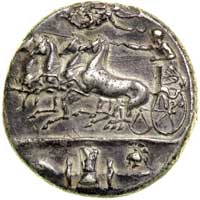 |
Sicily, Syrakuse. Dionysios I, 405-367 BC. Silver Dekadrachm (42.39g) struck 405-400 BC. Unsigned dies by Euainetos. Charioteer driving galloping quadriga left, holding kentron in right hand, reins in left; Nike (Victory) flying right above to crown the charioteer; below, military harness, shield, greaves, cuirass and Attic helmet, connected by a horizontal spear. Reverse: Head of Arethusa left wreathed in grain-ears, wearing a triple-pendant earring and a necklace; four dolphins swim around her. Gallatin, obv. R.III, rev. C.II; Rizzo pl. LIV, 8 (Boston MFA 421); Hirmer pl. 34, 104. A lovely example and nicely toned. Choice Very Fine.
The Syrakusan dekadrachms produced at the close of the fifth century BC by masters such as Kimon and Euainetos have long been the icons of ancient Greek numismatics, earning as British archaeologist Sir Arthur Evans said "the admiration of the ancient and modern world." "Italian pottery cups," notes Kraay (ACGC, p.232), "have a facsimile [of the dekadrachm] set in the base, no doubt imitating silver vessels, which incorporated actual decadrachms." The treatment of Arethusa on these coins has become a definition of classical beauty, while the coins' medallic size and stately artistry have made them centerpieces of Greek collections.
Like Syrakusan gold fractions struck at about the same time, these high-value coins were issued for some extraordinary purpose. Most likely this would be war, issued to provide financial support for mercenary troops, ships and supplies to wage battle, especially during this period against Carthage. The coin's beauty and artistry, meanwhile, were bold symbols of the glory of Syrakuse, a message that would be broadcast to allies and enemies alike.
Estimated Value $25,000 - 30,000.
Wolfen Family Foundation; Ex Bank Leu, sale 15, Zürich (4-5 May 1976), lot 119; Dr. J.H. Judd Collection, Hess-Leu sale 1957, lot 113; Baron v. Schennis Collection, Hirsch, sale 33 (1913), lot 464.
View details and enlarged photos
| Realized
$34,500 |
Lot 4024 |
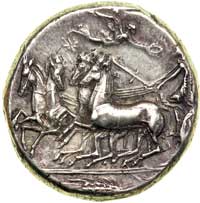 |
Sicily, Syrakuse. Dionysios I, 405-367 BC. Silver Tetradrachm (17.32g) struck ca. 405-395 BC. Dies by Eukleidas (unsigned). Charioteer driving quadriga left, holding kentron in left hand, reins in both; Nike (Victory) flying above to crown the charioteer; star above horses. (a very rare usage of an obverse symbol in this series), grain-ear left in exergue. Reverse: Head of Arethusa left, her hair in an ampyx and sphendone, wearing a loop earring and necklace, surrounded by four dolphins. Bold, fluid motion of the horses. Tudeer 87; Boston MFA 419; Gulbenkian 296; Dewing 852; de Hirsch 609. Even medium gray toning. A most beautiful example of this desirable issue. Extremely Fine.
Estimated Value $15,000 - 20,000.
Wolfen Family Foundation; Ex Bank Leu sale 15, Zürich (May 4 and 5, 1976), lot 115; Dr. J.H. Judd Collection.
View details and enlarged photos
| Realized
$29,900 |
Lot 4025 |
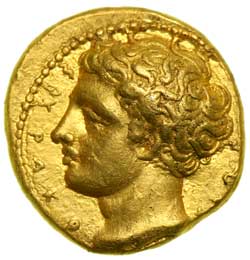 |
Sicily, Syrakuse. Second Democracy, Dionysius I, 405-395 BC. Gold Dekadrachm or 50 Litrai (2.88 g). ΣYPAKOΣIΩN. Young male head facing left; partial letters behind. Reverse: Free horse prancing right; [ΣYPA]KOΣIΩ[N]below two fine exergue lines. SNG ANS 340-344; SNG Cop. 688; Gulbenkian--. Some minor marks in the reverse field. Well struck in high relief. A lovely little Syrakusan jewel. Rare. NGC graded Choice AU; Strike: 5/5, Surface: 5/5.
Probably by the master Euainetos.
Estimated Value $5,000 - 6,000.
View details and enlarged photos
| Realized
$9,200 |
Lot 4026 |
 |
Sicily, Syrakuse. Timoleon and Third Democracy, 344-317 BC. Silver Stater (8.63g). Corinthian weight. Struck 344-335 BC. Pegasos flying left. Reverse: ΣYPAKOΣIΩN. Head of Athena right wearing unadorned Corinthian helmet. SNG ANS 496-507; Calciati 2. Lustrous. Superb Extremely Fine.
Estimated Value $1,500 - 2,000.
The Hunter Collection.
View details and enlarged photos
| Realized
$5,520 |
Lot 4027 |
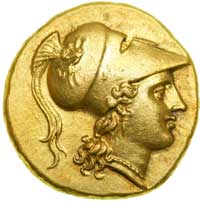 |
Sicily, Syrakuse. Agathokles, 317-289 BC. Gold Stater or Double Dekadrachm (5.66g) struck ca. 305-289 BC. Head of Athena right, wearing Corinthian helmet adorned with a griffin. Reverse: Winged thunderbolt; royal title above and below; beneath, Φ. Bérend, l'or pl. 9, 6; SNG ANS 702 var; Gulbenkian 339. A beautiful example of this lettered type. Very rare. Extremely Fine.
Known from six obverse and seven reverse dies, this handsome and short-lived coinage was clearly struck for a specific occasion, most likely in conjunction with preparations for renewed war with Carthage.
Estimated Value $6,000 - 8,000.
Ex Wolfen Family Foundation, purchased from Bank Leu early 1970s.
View details and enlarged photos
| Realized
$20,125 |
Lot 4028 |
 |
Sicily, Syrakuse. Agathokles, 317-289 BC. Gold Dekadrachm or 50 Litrai (4.3g) struck ca. 317-310 BC. Laureate head left of young Apollo; to right, grain ear. Reverse: ΣYP - AK - [OΣ - I] - Ω[N]. Fast biga right, the charioteer holding kentron in outstretched right hand, reins in left; below horses, triskeles. SNG ANS 553; Bérend, l'or, 1; SNG Lloyd 1473; Jameson 858. Extremely Fine.
Estimated Value $4,000 - 5,000.
The Hunter Collection.
View details and enlarged photos
| Realized
$6,038 |
Lot 4029 |
 |
Sicily, Syrakuse. Agathokles, 317-289 BC. Gold Dekadrachm or 50 Litrai (4.26g) struck ca. 317-311 BC. Laureate head of Apollo left; behind, kantharos. Reverse: Charioteer driving biga right, holding kentron in right hand, reins in left; below, triskeles. Cf. SNG ANS 552; SNG Cop 747 (no symbol); BMC 339. A few old obverse scratches. Choice Very Fine.
Estimated Value $2,500 - 3,000.
Wolfen Family Foundation, purchased from Bank Leu early 1970s.
View details and enlarged photos
| Realized
$2,760 |
Lot 4030 |
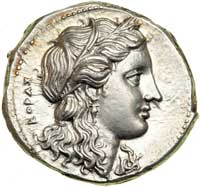 |
Sicily, Syrakuse. Agathokles, 317-289 BC. Silver Tetradrachm (17.0g) struck ca. 305-295 BC. KOPAΣ. Head of Persephone right, hair wreathed in grain leaves and loose down her neck, wearing pendant earring. Reverse: AΓA[ΘOKΛEIOΣ]. Nike (Victory), naked to waist, standing slightly right, holding hammer in right hand, nail in left, affixing helmet to trophy of arms; to right, triskeles. SNG ANS 665; Gulbenkian 331. A magnificent example with an extraordinary artistic rendering of Nike. Lustrous. Superb Extremely Fine.
Agathokles, tyrant of Syrakuse (317-289 BC), spent much of his reign in conflict with the Carthaginians. This elegantly styled tetradrachm, issued around 300 BC, bears the name of Agathokles on the reverse, where it accompanies a graceful standing figure of Nike. The symbolism probably relates to Agathokles bold invasion of Africa, where he almost succeeded in capturing Carthage itself. The type is curiously similar to a contemporary issue of Seleukos I, Nikator at the eastern end of the Greek world, though whether one or the other served as a prototype is unclear. The obverse features a head of Persephone who is named Kore (Maiden) in the inscription behind. Her substitution for the usual Arethusa head would seem to be part of Agathokles' attempt to unite the various Sicilian Greek factions under his leadership.
Estimated Value $5,000 - 7,000.
The Hunter Collection.
View details and enlarged photos
| Realized
$23,000 |
Lot 4031 |
 |
Sicily, Syrakuse. Hieron II, 275-215 BC. Gold Drachm or 100 Litrai (4.2g) struck ca. 269-215 BC. Head of Persephone left, hair wreathed in grain-leaves and loose down her neck, wearing pendant earring and beaded necklace; to right, poppy head. Reverse: IEPΩNOΣ. Fast biga right, the charioteer holding kentron in left hand. As usual, struck from slightly rusty dies. Traces of double striking on reverse noted. Rare variety absent in most collections. Lustrous. Extremely Fine.
Estimated Value $3,000 - 4,000.
The Hunter Collection.
View details and enlarged photos
| Realized
$5,750 |
Lot 4032 |
 |
Spain, Carthago Nova. The Barcids. Time of Hannibal, ca. 221-208 BC. Silver Double Shekel (14.7g). Minted at Carthago Nova, ca. 220 BC. Laureate, bearded head left of Herakles-Melqart(?), the strongly Semitic features suggesting Hamilcar Barca (father of Hannibal), with heavy, knotted club over far shoulder. Reverse: Mahout wearing long cloak and cap(?), holding goad in right hand, and riding African elephant right. CNH 13 (same dies); Gulbenkian 389 (same dies); Robinson, Essays-Mattingly, 6a (same dies). Boldly struck in high relief and well centered. A powerful portrait of the finest style of the period. Probably the finest known specimen. Superb Extremely Fine.
Rome's success in the First Punic War (241 BC) and the subsequent uprising of the former Punic allies in North Africa (the Libyan Revolt) forced the Carthaginians to reassess their formerly dominant position in the western Mediterranean region. Hamilcar Barca, a member of a noted aristocratic family of Carthage, made his eldest son Hannibal swear a sacred oath to "never be a friend of Rome." The family then moved to Spain "to call a new world into existence to redress the balance of the old." Here Hamilcar began preparations for an attack on the Roman Republic, but he was not destined to live to see the fulfillment of his plans. His son-in-law and successor Hasdrubal (228-221 BC), the founder of Carthago Nova, continued the work, and in 218/217 BC Hannibal was ready to launch the invasion into Italy. Rome was totally unprepared for a wintertime attack from the north, and, thus, the epic story of Hannibal's crossing of the Alps with a contingent of elephants has become the stuff of legend. In the ensuing fifteen-year war, Hannibal ultimately failed to bring about the destruction of the Roman Republic, but of all Rome's opponents he came closest to overthrowing the state that was to dominate the Mediterranean region over the following six hundred years. This silver double shekel is one of the rarest and most remarkable types of the Barcid coinage. The bearded head of Melkart was interpreted by Robinson as a portrait of Hamilcar, father of Hannibal and founder of the dynasty in Spain.
Estimated Value $70,000 - 80,000.
The Hunter Collection; Purchased from Ed Waddell at NYINC in 1990s.
View details and enlarged photos
| Realized
$299,000 |
Lot 4033 |
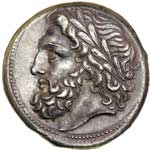 |
Sicily, Syrakuse. Fifth Democracy, 214-212 BC. Silver 16 Litrai (13.54g). Laureate, bearded head of Zeus left. Reverse: ΣYPAKOΣIΩN. Nike (Victory) driving fast quadriga right, holding reins in both hands and kentron in left; below horses' forelegs, ΞI. Burnett, SNR 62, pl. 8, D3 = Gulbenkian 358 (same dies). Attractively toned. A fantasitc example of powerful Hellenistic style. Superb Extremely Fine.
This handsome Hellenistic rendering of the head of Zeus, produced at the very end of the period of the city's independence, provides a fitting final testament to the magnificence of the Syrakusan coinage over the preceding three centuries. Its issue should be set against the backdrop of turmoil in the city following the rejection of the Roman alliance by Syrakuse's last king Hieronymos (215-214 BC). His subsequent assassination led to the reestablishment of democratic government in Syrakuse (Fifth Democracy, 214-212 BC) and the city's subsequent siege and capture by the Romans under M. Claudius Marcellus. The Nike in a galloping four-horse chariot on the reverse speaks to the forlorn hope of the Sicilian Greeks that they could withstand the onslaught of the Roman forces.
Estimated Value $40,000 - 50,000.
The Hunter Collection; Ex Numismatic Fine Arts XII, 23-24 March 1983, lot 30.
View details and enlarged photos
| Realized
$77,625 |
Lot 4034 |
 |
Sicily, Syrakuse. Hieronymos, 215-214 BC. Silver 10 Litrai (8.47g). Diademed head of Hieronymos left sporting a sideburn. Reverse: Horizontal winged thunderbolt; above, AΦ. Holloway 28 (O13/R22); cf. Leu 15, 1976, lot 135 (same dies). Extremely Fine.
Estimated Value $1,000 - 1,300.
View details and enlarged photos
| Realized
$1,610 |
Lot 4035 |
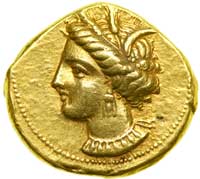 |
Carthage. Gold Stater (9.23g) struck 350-320 BC. Wreathed head of Tanit left wearing a triple-pendant earring and necklace. Reverse: Horse, its mane proud, standing right. Jenkins & Lewis Group III, MAA 4. A very pleasing example. Extremely Fine.
Estimated Value $5,000 - 6,000.
Wolfen Family Foundation, purchased from Bank Leu early 1970s.
View details and enlarged photos
| Realized
$6,038 |
Lot 4036 |
 |
Carthage. Elektrum Fifth Shekel (1.5g) struck ca. 320-310 BC. Head left of Tanit, hair wreathed with grain leaves, wearing single-drop earring and heavy necklace with pendants. Reverse: Horse standing right, head reverted; to left of forelegs, pellet. Jenkins & Lewis Group IV, 235. Attractive natural golden highlights. Lustrous surfaces. Superb Extremely Fine.
Estimated Value $2,000 - 2,500.
The Hunter Collection.
View details and enlarged photos
| Realized
$5,290 |
Lot 4037 |
 |
Carthage. Second Punic War. Billon Tridrachm (9.2g) ca. 203-201 BC. Wreathed head of Tanit left, wearing triple-pendant earring; the profile wide-faced with a thin, sharply defined nose and forehead. Reverse: Horse walking right, its head reversed, raising front leg. El Djem hoard type, cf. SNG Cop 392. Trivial earthen deposits on reverse. Very rare. Nearly Extremely Fine.
This lovely coin with its earthy Tanit and semi-ethereal horse was probably the last coin issue of Carthage. It was most likely struck after the invasion of North Africa by Publius Cornelius Scipio in 204 BC and until some months following Hannibal's defeat at the Battle of Zama in the fall of 202 BC with the crippling peace treaty the Carthaginian assembly accepted.
Estimated Value $1,500 - 2,000.
The Hunter Collection; purchased from the Goldbergs January 15, 1983.
View details and enlarged photos
| Realized
$6,325 |
Lot 4038 |
 |
Carthage. Third Punic War, ca. 149-146 BC. Gold Serrate Two-Fifths Shekel (3.0g). Head of Tanit, grain-wreathed, left, wearing single pendant earring. Reverse: Horse walking right; pellet before its chest. Jenkins & Lewis group XVIII, 506 var. (pellet below leg); SNG Cop 401 var (pellet below leg). Well struck and unusually well centered. Very rare. Choice Very Fine.
H.R. Baldus ("Ein 146 v. Chr. verbrannter Geldbörseninhalt aus Karthago," Chiron 33 [2003]) put forth the compelling argument that coins of this serrated issue were struck from melted jewelry contributed in the summer of 149 BC by the women of Carthage after the Roman siege of their city had begun. The ancient Greek historian Diodorus Siculus tells us that "in preparation of the coming siege [of Carthage]…women shave off their hair to be woven into cords for use in catapults and contribute their gold jewelry to help finance the war effort" (Diodorus Sicilus 32.9).
Estimated Value $1,000 - 1,500.
The Hunter Collection.
View details and enlarged photos
| Realized
$5,290 |
Lot 4039 |
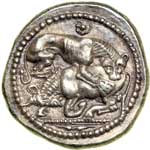 |
Macedonia, Acanthus / Akanthos. Silver Tetradrachm (16.9g) struck ca. 470-430 BC. Lioness right, head facing, attacking bull collapsing left, head reverted and grounded; above, pellet-in-annulet; in exergue, floral motif; beaded border and exergual line. Reverse: Quadripartite incuse square. Cf. Desneux Type G (position of bull's head); otherwise unpublished. Attractive antique toning. An outstanding finely detailed example. Superb Extremely Fine.
A lion attacking a bull was an ambitious design for die-engravers of the archaic period, and their efforts often resulted in a somewhat confused appearance. On this specimen, however, the artist has successfully represented his subject with an unusual degree of clarity. The symbolism may be Anatolian in origin and relate to the worship of Cybele. However, lions and wild bulls are known to have abounded in this region, and such scenes of combat may well have been familiar to the citizens of Akanthos. The city was situated on the isthmus connecting the peninsula of Acte with Chalcidice and was founded by colonists from the island of Andros. Early issues, commencing in the last quarter of the sixth century, lacked an ethnic but the full city name was added surrounding the square during the 460s BC.
Estimated Value $12,000 - 16,000.
The Hunter Collection.
View details and enlarged photos
| Realized
$35,650 |
Lot 4040 |
 |
Macedonia, Mende. Silver Tetradrachm (17.5g) struck ca. 430-423 BC. Bearded Dionysos reclining left, head three-fourths right, holding kantharos in raised right hand, atop ass walking right; below, bunch of grapes on branch. Reverse: MEN - ΔA - I - ON. Grapevine with four clusters of fruit within linear frame; all within square incuse. Die combination not documented in the major references. Noe Group III, cf. 81 (no grape branch on obverse; fifth cluster on reverse), 85 (same reverse die). Delicate natural grey toning deepening within the recesses. Well struck in high relief. Extremely Fine/Very Fine.
Mende was a colony of Eretria and was celebrated for the excellent quality of its wine. The wealth derived from this source helped to finance an extensive series of silver tetradrachms during the third quarter of the fifth century BC. Not surprisingly, the types of this coinage celebrate Dionysos, god of wine, and similar designs were used for the stamps on the wine amphorae. The deity is shown in a relaxed pose, doubtless in a state of intoxication, reclining on the back of an ass and holding a large wine cup or kantharos. The reverse type is also on a viticultural theme and features a vine with bunches of grapes.
Estimated Value $12,000 - 16,000.
The Hunter Collection; Ex Superior Stamp & Coin, June 2 1992, lot 4394.
View details and enlarged photos
| Realized
$12,075 |
Lot 4041 |
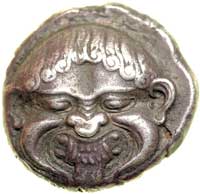 |
Macedonia, Neapolis. Silver Stater (9.86g) ca. 500-480 BC. Facing gorgoneion, tongue protruding. Reverse: Quadripartite incuse square. SNG ANS 406-419, Traité I, 1740; Dewing 1064. Deep purple-gray. Bold types. Nearly Extremely Fine/About Very Fine.
Estimated Value $4,000 - 5,000.
Wolfen Family Foundation, purchased from Bank Leu early 1970s.
View details and enlarged photos
| Realized
$2,530 |
Lot 4042 |
 |
Macedonian Kingdom. Alexander I, 498-454 BC. Silver Oktadrachm (28.6g) struck ca. 492-479 BC. Horseman, wearing petasos and chlamys, carrying two spears, leading horse right. Reverse: Quadripartite incuse square. SNG ANS 1 = Rosen 17; SNG Lockett 1266. Soft gray toning. Excellent metal for issue, and unusually well struck. Extremely rare. Superb Extremely Fine.
The tribal coinages of Macedonia and Thrace share many common characteristics. This coin clearly points to the existence of some kind of tribal alliance which is hardly surprising in the light of their brief period of issue, probably no more than about three and half decades from the late sixth to the early fifth century BC. The obligation to pay tribute in silver to the Persian Empire led to the production of very large denominations, examples of which are more often found within Achaemenid territory than in their area of manufacture. This silver oktadrachm was long attributed to the Bisaltai, a powerful Thraco-Macedonian tribe that occupied land west of the Strymon River, which included the argentiferous mountains separating the Valley of Strymon from Mygdonia. Recent evidence, though, now sugests that this was the earliest issue of Alexander I of Macedon, struck while he was allied with the tribes against the Persians. Out of diplomatic necessity, Alexander would logically strike coins that his allies would find acceptable and familiar. After the defeat of the Persians at the Battle of Plataea in 479 BC, thus ending their invasion of Greece, and their retreat into Asia Minor, Alexander I acquired all of the Bisaltai territory as far the Strymon, including the silver-rich mines. At some point afterwards, he bgean adding his name to the reverse of similar type of oktadrachms.
Although issued anonymously, this handsome oktadrachm was probably struck under Alexander I of Macedon (ca. 498-454 BC). An otherwise identical oktadrachm actually bears the name of Alexander around the incuse square on the reverse (Kraay, Archaic and Classical Greek Coins, 495). The obverse depicts a huntsman walking beside his horse, a type that appears also on the coinage of the Bisalti tribe.
Estimated Value $15,000 - 20,000.
The Hunter Collection; Ex Superior Stamp & Coin NYINC Auction, December 8-9, 1995, lot 807.
View details and enlarged photos
| Realized
$27,600 |
Lot 4043 |
 |
Macedonian Kingdom. Philip II, 359-336 BC. Silver Tetradrachm (14.36g) minted at Pella 323 BC. Struck under Philip III and Kassander as regent. Laureate head of Zeus facing right. Reverse: Naked youth on horseback right, carrying palm; coiled serpent below; Boeotian shield below raised foreleg. Le Rider 525a; cf. SNG ANS 449. Well centered on a large flan. Exceptionally fine style for this period at Pella. Lustrous. Superb Extremely Fine.
Estimated Value $2,000 - 3,000.
Ex Classical Numismatic Group 64 (Sept. 24, 2003) Lot 84.
View details and enlarged photos
| Realized
$4,140 |
Lot 4044 |
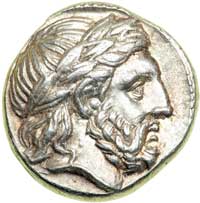 |
Macedonian Kingdom. Philip II, 359-336 BC. Silver Tetradrachm (14.3g) minted at Amphipolis. Struck under Kassander as regent. Laureate head of Zeus right. Reverse: Youth, holding a palm frond, on horseback right; dolphin with large snout below horse's belly; Π below its raised foreleg. Le Rider pl.46, 19; Troxell Studies group 9, 331-2; SNG ANS 751. A very choice specimen. Lustrous. Nearly Mint State.
Estimated Value $1,000 - 1,300.
The Hunter Collection.
View details and enlarged photos
| Realized
$1,380 |
Lot 4045 |
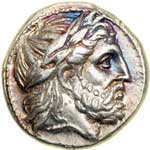 |
Macedonian Kingdom. Philip II, 359-336 BC. Silver Tetradrachm (14.1g). Minted at Amphipolis, ca. 316 BC or later. Philip II reissue by Kassander as regent. Laureate head of Zeus right. Reverse: ΦIΛIΠ - ΠOY. Naked youth riding right, holding palm in right hand, reins in left; below horse's belly, wreath; below raised foreleg, pellet within Π. Troxell group 9, 328-330; SNG ANS 747-748; Le Rider pl. 46, 14. Delicately toned with soft pastel colors. Lustrous. Superb Extremely Fine.
Estimated Value $1,000 - 1,300.
The Hunter Collection.
View details and enlarged photos
| Realized
$1,495 |
Lot 4046 |
 |
Macedonian Kingdom. Alexander III, the Great, 336-323 BC. Gold Distater (17.23g). Minted at Amphipolis, ca. 330-320 BC. Head of Athena right in crested Corinthian helmet ornamented with serpent. Reverse: AΛEΞANΔPOY. Nike (Victory) standing left, holding wreath and stylis; in left field, trident head. Price 171; SNG Cop. 622; Troxell 532. A pleasing problem-free example. Well struck in high relief. Nearly Extremely Fine.
Estimated Value $15,000 - 20,000.
Ex Morton & Eden, Oct. 24, 201, lot 97; Spink, London, June 30, 1965.
View details and enlarged photos
| Unsold |
Lot 4047 |
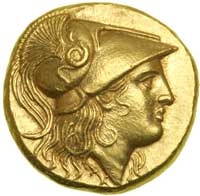 |
Macedonian Kingdom. Alexander III, the Great, 336-323 BC. Gold Stater (8.6g) minted at Miletos, ca. 325-323 BC. Struck under Philoxenos. Head of Athena right wearing a crested Attic helmet adorned with a coiled serpent, three of her locks, curling tendrils. Reverse: Nike (Victory) standing left holding wreath in outstretched right hand and stylis in left; HΔ monogram in left field. Price 2078; SNG Ashmolean 2774. Lovely style. Finely detailed and a superb figure of Nike. Extremely Fine.
Estimated Value $2,500 - 3,000.
The Hunter Collection.
View details and enlarged photos
| Realized
$5,750 |
Lot 4048 |
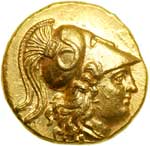 |
Macedonian Kingdom. Alexander III, the Great, 336-323 BC. Gold Stater (8.6g) minted at Sidon, CY 13 (321/320BC). Struck under Philip III Arrhidaios Head of Athena right wearing a crested Attic helmet decorated with a coiled serpent, and a necklace. Reverse: Nike (Victory) standing left holding a wreath in her outstretched right hand and a stylis in left; date "N" below wing in left field (the letter has been blundered by the strike). Price 350; Newell Sidon 38. Bold details and lustrous. Superb Extremely Fine.
Estimated Value $4,000 - 5,000.
View details and enlarged photos
| Realized
$4,600 |
Lot 4049 |
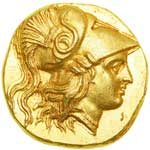 |
Macedonian Kingdom. Alexander III, the Great, 336-323 BC. Gold Stater (8.59g) minted at Sidon, 316/315 BC. Struck under Ptolemy I, Soter as satrap. Head of Athena right wearing triple-crested Corinthian helmet adorned with twice-coiled snake right, and wearing beaded necklace. Reverse: [A]ΛEΞANΔPOY. Nike (Victory) standing left, holding wreath in right hand, stylis in left; to left, Σ (year 18). Price 3503 (same reverse die as 3503b). Finely detailed. A remarkable specimen. Lustrous. Nearly Mint State.
Estimated Value $4,000 - 6,000.
The Hunter Collection.
View details and enlarged photos
| Realized
$12,075 |
|
|